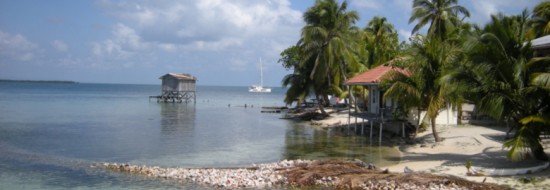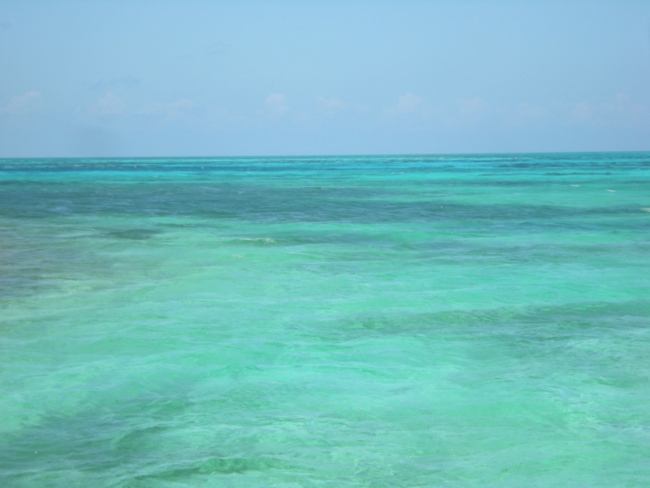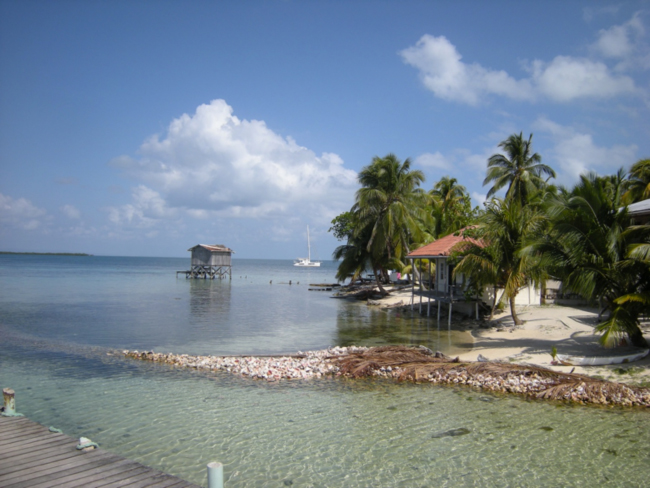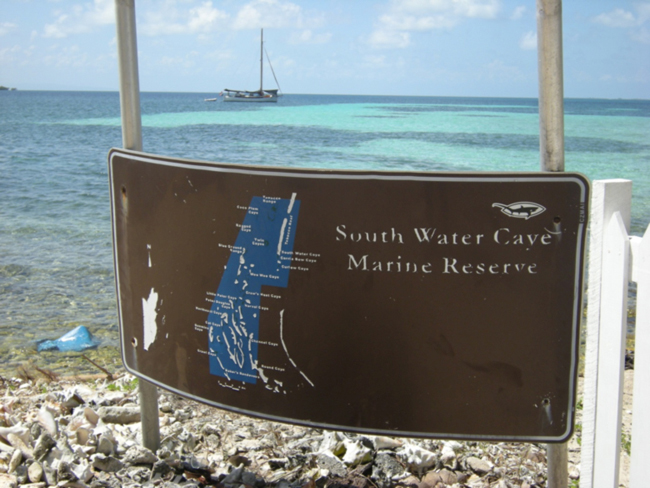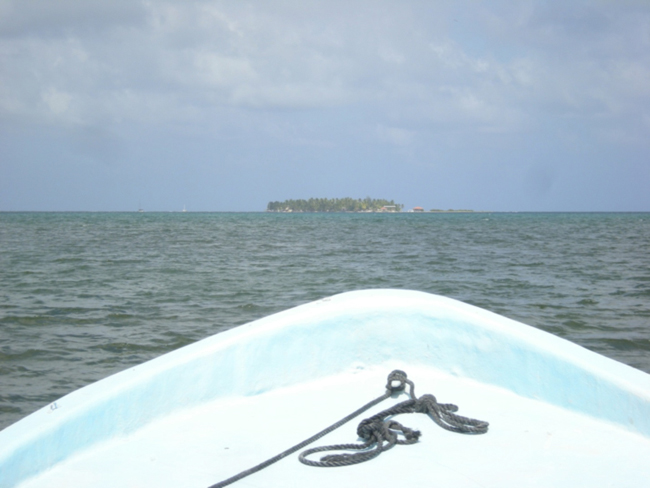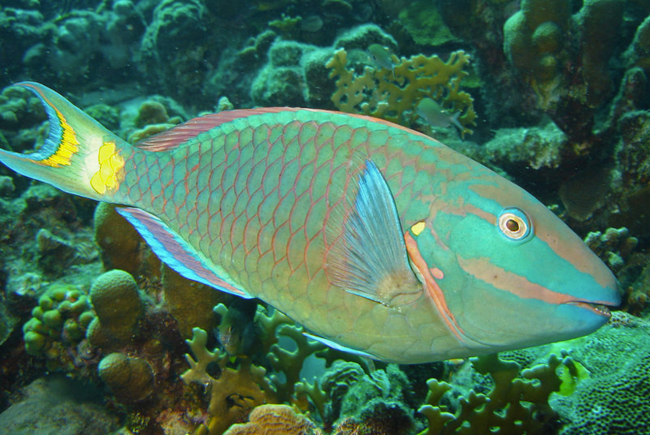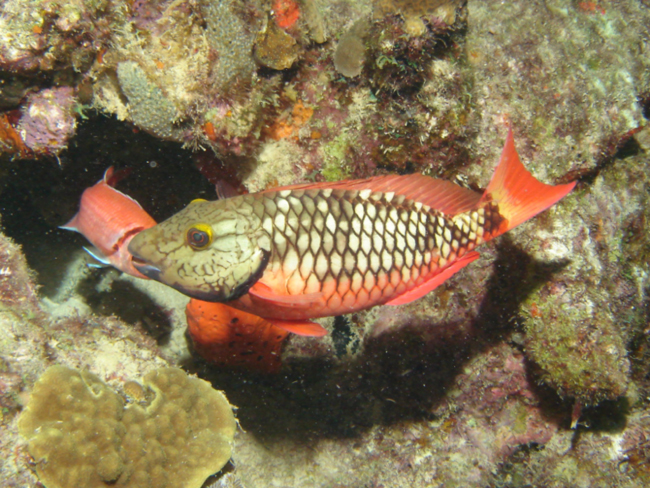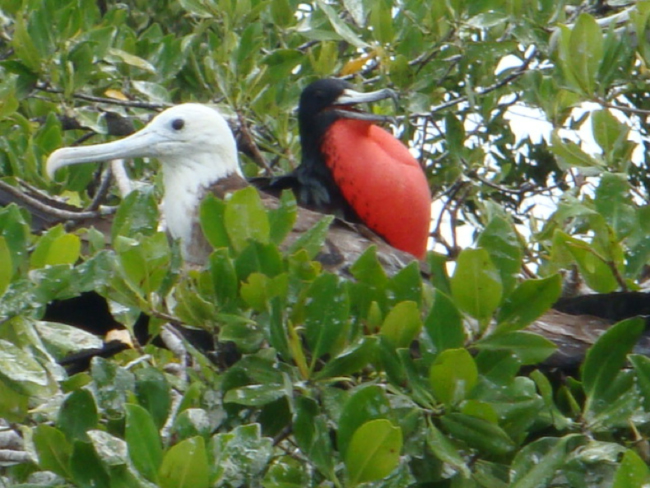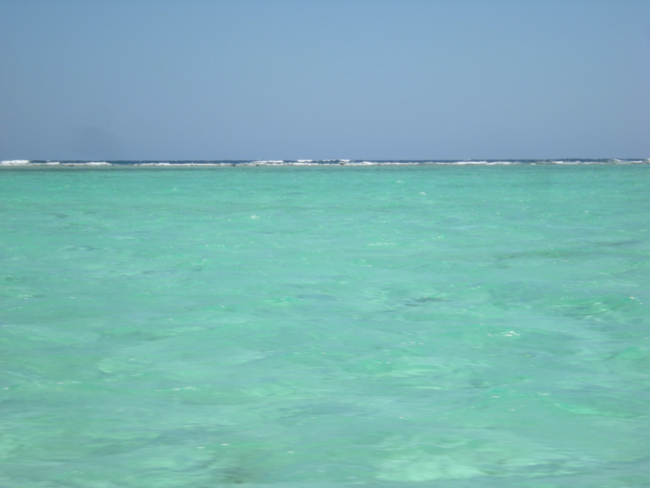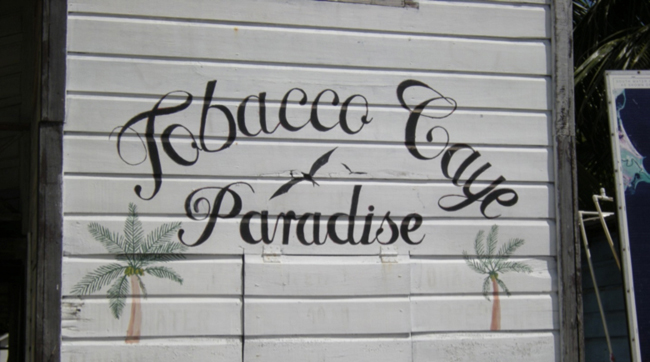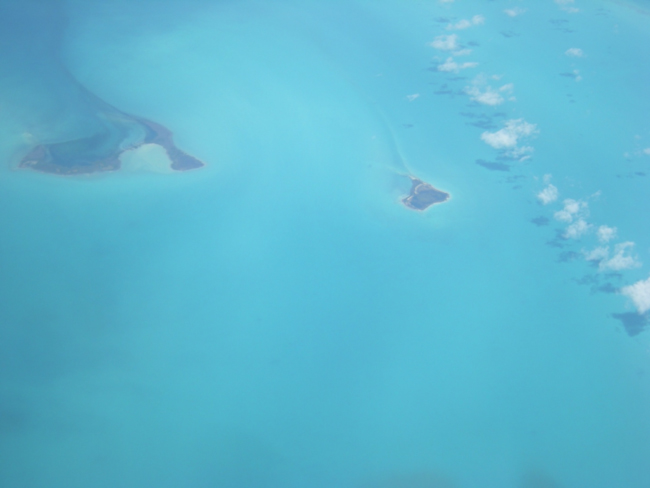Earth is a water planet. Over seventy percent of her surface is water (the word “earth” comes from roots in ancient Germanic languages, and she was portrayed as a goddess, hence “her”), and the atmosphere is full of gaseous water. And so she’s a blue planet. The blues of the sea and sky are the result of an intrinsic property of water molecules, which absorb red wavelengths of light and allow blue wavelengths to pass, reflect, and echo. Last week, on Glover’s Reef, an atoll three hours by small boat off the coast of Belize, the palette of blues seemed more heavenly than earthly. Nothing can compete with a bottom of white coral sand and gin-clear tropical water to bring out Earth’s blues.
Glover’s Reef, or perhaps better called Glover’s Atoll, is one of three atolls found east of the Belizean Barrier Reef. It is named after the 17th century pirate John Glover, who used it as a base to raid Spanish ships carrying New World treasure from Cartagena to Cadiz. Belize’s barrier reef makes up the central section of the Meso-American Barrier Reef, the second-longest in the world after the Great Barrier Reef of eastern Australia. The Belize Barrier Reef system, including the offshore atolls, was designated a UNESCO World Heritage Site in 1996.
Atolls – ringlike reefs and coral islands enclosing a central lagoon – are a biogeological feature of our blue planet that were first explained by Charles Darwin in a publication titledThe Structure and Distribution of Coral Reefs, Being the first part of the geology of the voyage of the Beagle, under the command of Capt. Fitzroy, R.N. during the years 1832 to 1836. This was Darwin’s first monograph, published in 1842, seventeen years before The Origin of Species. It demonstrates the way his mind was working: as also later in The Origin, he was trying to show that what we see now can be explained by long, slow processes at work in geological or biological systems, and that these processes can be deduced from looking at current evidence and running the “evolutionary” clock backward in time in a mental experiment. As Darwin explained, atolls are created when a former reef-fringed island of non-coral rock sinks beneath a tropical sea at a slow enough rate that coral growth can keep up with its submersion, maintaining a ring of reefs at the surface.
Glover’s Atoll marks the edges of a piece of crustal rock that was once connected to the Maya Mountains, the high core of central Belize now on its western border with Guatemala. Plate tectonics – another slow evolutionary process in the Earth-system – explains what happened. As the Caribbean Plate drifted east, this chunk of ancient crustal rock was torn off the east coast of Belize, as it slowly collapsed into the Cayman Trench like hunks of riverbank caving off into an undercutting river. As it slid under the blue sea, coral growth kept its reefs close to the surface. Glover’s is a large atoll, with an area of about 90 square miles and around 700 patch reefs inside the encircling outer reef. The steep eastern face drops 3,000 feet in a wall toward the depths of the Cayman Trench.
My first visit to Glover’s Reef was in October, 2007, one of several site visits that were part of an end-of-program evaluation of USAID’s Global Conservation Program, a ten-year, $72 million investment by USAID in biodiversity conservation, implemented through many of the largest conservation NGOs in the U.S.. At Glover’s, the Wildlife Conservation Society had been implementing a large-scale approach to conservation based on the ecological requirements of selected target species. At Glover’s Reef, those target species included the Nassau grouper, hawksbill turtle, and queen conch. Conserving them led to work with fishermen’s associations from Garifuna communities on the mainland to monitor catch levels, and with the Belize Fisheries Department to enforce zoning regulations and harvest limits within the marine reserve. The evaluation trip was so quick that we didn’t even have time to put on mask, snorkel, and fins and look beneath the surface, so to speak. I have wanted to return ever since.
This time we broke our trip to Glover’s by stopping and staying on Tobacco Caye, a tiny coral island on the barrier reef less than an hour out from Dangriga. Tobacco Caye lies at the northern end of the South Water Caye Marine Reserve, one of eight multiple-use marine reserves in Belize. Several small lodges crowd the tiny island, all catering to a clientele interested in varying combinations of nature tourism oriented toward snorkeling and diving, relaxing in hammocks under palm trees, and drinking rum punch. We stayed at Reef’s End Lodge on the southern end of the caye. It was only a five-minute walk to Paradise, a lodge on the northern end, but after a few days, Reef’s End seemed a long way from Paradise. Unlike Paradise, Reef’s End was on the leeward side of the island. There were no strong fresh breezes to blow the mosquitoes away, and so they mounted a full attack every night starting at midnight, just as the generator-powered electricity cut off, and the fan in our room that had been holding them at bay also died, and the steamy tropical night and its buzzing army overran us through the mostly-screenless windows, disrupting our paradisiacal dreams with itching nightmares.
Despite its physical and mental challenges, Reef’s End provided a base from which to experience the blue world. One day we headed west, looking for manatees in the seagrass flats between Tobacco Caye and the mangrove islands of Tobacco Range, but didn’t find any of the muddy patches that show where they are feeding below. We eased into a mangrove-lined inlet, and slipped into the warm water with masks and snorkels to explore the alcoves and overhangs among the prop roots, astounded by the density of fish there, from schools of hundreds of tiny silverlings to patrols of big blues. We finished the morning snorkeling just inside the barrier reef across the channel from Tobacco Caye, a fantastical coral world, and came back to a lunch of fresh-caught barracuda and coconut rice.
The next day we headed east across windy open water almost two hours to Glover’s Atoll. From Glover’s Northeast Caye we waded into the lagoon and swam out over flats of seagrass and black and white urchins until the bottom of white coral sand dropped away to twenty or thirty feet, and big coral heads rose up. We kicked south against the current, and then drifted back, waves breaking on the reef creating pulsing water-winds that pulled the purple sea fans back and forth. We hovered, relaxed, drifted, and marveled at the bustling colorful scenes below, weightless, as if watching life on another planet from an orbiting alien spaceship. There were big round lobes of brain coral, flattened horns of elkhorn coral, and sharp antlers of staghorn coral. Rainbows of fish swirled past in schools or solo: parrotfish, angelfish, butterflyfish, damselfish, needlefish, jacks, tangs, grunts, groupers, and snappers. I estimated that I saw 30 to 40 different kinds of fish, but after coming out of the water I could hardly even remember or describe most of their kaleidoscopic patterns. My personal favorite was an electric-dayglow-rainbow-colored parrotfish, which memory and later internet sleuthing allowed me to positively identify as the male terminal phase of the stoplight parrotfish, Sparisoma viride.
I learned later also that this and other parrotfish are able to change sex as they mature, and that “the colors of the stoplight parrotfish in the initial phase, when it could be either a male or a female, are dramatically different from those in the terminal phase, when it is definitely a male.” I then realized I had also seen plenty of the ambisexual “initial phase,” with their red, black, and pearlspotted patterns. [Hello, Charles Darwin: how are we supposed to explain this sex and color changing stuff?]
Wind is a constant companion on the cayes and waters here. Many of our passages were rough and wet. Above us always on these crossings were magnificent frigatebirds, Fregata magnificens, faithful friends of the wind. One morning we circled Man O’War Caye, a tiny mangrove-covered islet hardly bigger than a suburban backyard, where hundreds of frigatebirds nest. The air over the islet was aswirl with frigates. Frigatebirds are designed to soar, watching and waiting for other feeding seabirds, then harassing them so they drop the fish they have found, which the frigates then grab in mid-air. They are the pirates of the skies, stealing from the fat gulls, pelicans, and terns, just as John Glover preyed on the gold-laden Spanish galleons.
Oh, I just realized that when I titled this story “Belizean Blues,” maybe you were thinking music? There are roots of musical blues in Belize too. Just listen to Andy Palacio and the Garifuna Collective – their song “Baba,” for example, “Father.” It can break your heart if you are in a blue mood. The Belizean Garifuna culture is centered in Dangriga and Hopkins, towns on the coast straight west of Tobacco Caye and Glover’s Reef. Garifuna fishermen are fishing out there every day. Their ancestors were a fusion of shipwrecked African slaves who intermarried with Native American Carib people, and after being forced from their stronghold on the island of St. Vincent by French and English colonial machinations, they eventually resettled on the Caribbean coasts of Belize, Guatemala, Honduras, and Nicaragua. Garifuna history records a long struggle for survival, and they carry that weight in their music, expressed with some of the same shades of the blues palette as our North American blues, which passed through the Caribbean and southern sugar and slave culture to New Orleans and up the Mississippi.
Oh – or maybe you were thinking of the emotion, the “blues”: a kind of longing, a kind of sadness, but with a strong and yet still tender heart? There is that too, among these blue waters. Global climate change is stressing and threatening the atolls and reefs due to the inevitable sea level rise that will accompany climate warming. Walking Tobacco Caye from south to north, I guessed that its highest point was about ten feet above the waves lapping on all sides. Given the projections by the Intergovernmental Panel on Climate Change in its 2013 assessment report of an average sea level rise of one-and-a-half to three feet worldwide, a significant part of the caye, including its edges at Reef’s End and Paradise, may go underwater. A less-understood threat is the acidification of the oceans caused by our burning of fossil fuels that is thought will stress the ability of corals and other marine organisms to create their carbonate skeletons. But these reefs have survived and evolved under all the changes experienced by our water planet over hundreds of millions of years, so maybe they will survive the climate change and ocean acidification that our greedy species is creating for them now.
The first of the “Four Noble Truths” of Buddhism is often translated as “life is suffering.” But that’s a misperception of what Gautama, the historical buddha, meant when he said “life is dukkha.” The Pali word dukkha probably meant something more like “unsatisfactory” or “stressful” or “imperfect.” A better rendition of the buddha’s meaning might be: “If you expect too much you will be disappointed.” Or: “Just relax, life ain’t paradise.” Or, maybe just to make a metaphorical stretch: “Earth is a blue planet, so life on Earth is blue.” The blues are just the existential color of life on this watery, wonderful, changeable, ephemeral Earth.
Whichever blues are your hues, all I know is that after snorkeling at Glover’s Reef, my dreams are filled with rainbow fishes swirling around big coral heads rising from white sands in transparent water in an embracing sea of heavenly, Earthly blue.
See more pictures
Related links
- Geology of Belize
- Glover’s Reef Atoll information and map
- USAID Global Conservation Program Final Evaluation Report
- VIDEO: Andy Palacio and the Garifuna Collective, “Baba”

